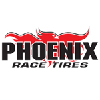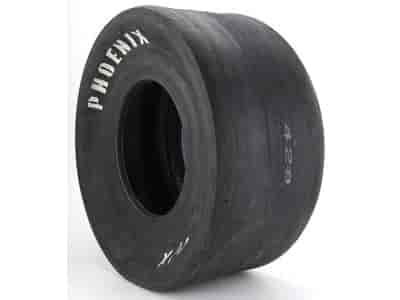12.2'' Tread Width
Proper Tire Rollout Measurement Instructions
| Tire Compound: | F9 |
| Tire Overall Diameter: | 31.8'' |
| Average Roll Out/ Circumference: | 99.5'' |
| Tire Tread Width: | 13.4'' |
| Tire Section Width: | 16.5'' |
| Wheel Diameter: | 15'' |
| Spec Wheel Width: | 14'' |
| Tire Weight: | 33.0 lbs |
| Suggested Tube Part Number: | 672-9558 |
NOTE:
All Classes: All cars should run tubes as they add to the overall stability of the tire / wheel package and repeatability of the tire from run to run.
Air Pressure: The best rule of thumb is to use as much air as possible for the track conditions without making the tire spin.
Tire Rotation: Tires should be mounted in the direction of the arrows. After several passes the tires can be swapped side to side. This rotation should occur whenever a medium grain appears on the tread face of the tire. Most cars can get by with rotation every 12 to 20 passes. In some cases you will need to rotate every couple of passes.
Burn-Outs: Compound improvements have helped to reduce the need for long smoky burn-outs. Drive through the water box to prevent excess water being trapped in body panels, lock anti-roll device, begin burnout, watch for smoke to rise. At that time release braking device and accelerate to the start line. Go directly to the start line, it is not recommended to do any dry hops, as this will allow better heat transfer to the track surface. Please note, that this is a general guideline and if in your experience with your vehicle you have found that another combination in the burn-out process will work better, use your approach.
Tire Storage: As with any rubber article, tires should not be stored in extreme heat or direct sunlight. Keep tires away from any high voltage electric motors and do not store on a concrete surface. Tires should be stored at room temperature and placed in a dark plastic bag and sealed if being stored for a long period of time. It is not recommended that traction restore or traction bite compounds be used, as once they are applied, they must be applied each time you race. These compounds create a chemical reaction which can result in a change to the compound (SEE WARNING BELOW).
Mounting: Upon mounting of tires, check circumference of the set for matching sizes. This is to be done before installing rim screws. Adjust tires within 1/4? before running. Proper sizing is required for safety reasons. DO NOT USE ANY LIQUID FLAT FIXERS, as this will cause an out-of-balance condition. USE A TUBE FOR FLATS.
WARNING: NEVER attempt to chemically treat or alter the tire and/or tread compound of the tire, such as soaking or the use of tread softener. This could result in premature or catastrophic tire failure with resulting serious injury or death. Tire changing should be done by trained personnel using proper tools and procedures. Failure to follow stated mounting procedures could cause faulty positioning of the tire and cause assembly to burst with explosive force sufficient to cause serious injury or death. Clean rim, lubricate rim and beads with rubber lubricant. ALWAYS lock wheel on mounting machine or place in safety cage, and use extension gauge and hose with clip-on air chuck. STAND BACK, NEVER exceed 35 PSI to seat beads.
Specifications:
Motor Vehicles
WARNING: Motor vehicles contain fuel, oils and fluids, battery posts, terminals and related accessories which contain lead and lead compounds and other chemicals known to the State of California to cause cancer, birth defects and other reproductive harm. These chemicals are found in vehicles, vehicle parts and accessories, both new and as replacements. When being serviced, these vehicles generate used oil, waste fluids, grease, fumes and particulates, all known to the State of California to cause cancer, birth defects, and reproductive harm.
Tools:
WARNING: Some dust created by power sanding, sawing, grinding, drilling, and other construction activities contains chemicals known to the State of California to cause cancer and birth defects or other reproductive harm. Some examples of these chemicals are: lead from lead-based paints, crystalline silica from bricks and cement and other masonry products, and arsenic and chromium from chemically treated lumber. Your risk from exposure to these chemicals varies, depending on how often you do this type of work. To reduce your exposure, work in a well-ventilated area and with approved safety equipment, such as dust masks that are specially designed to filter out microscopic particles.
Electrical Cords
WARNING: The wires of these products contain chemicals known to the State of California to cause cancer and birth defects or other reproductive harm. Wash hands after handling.

